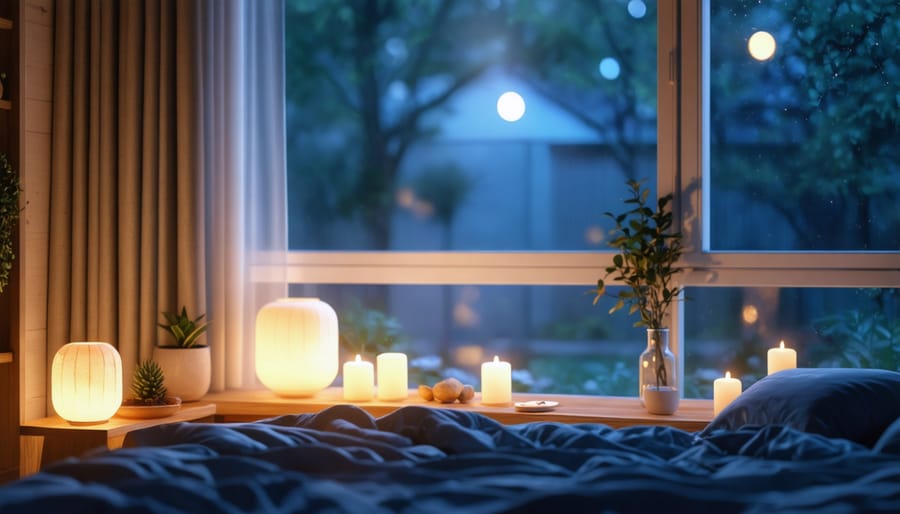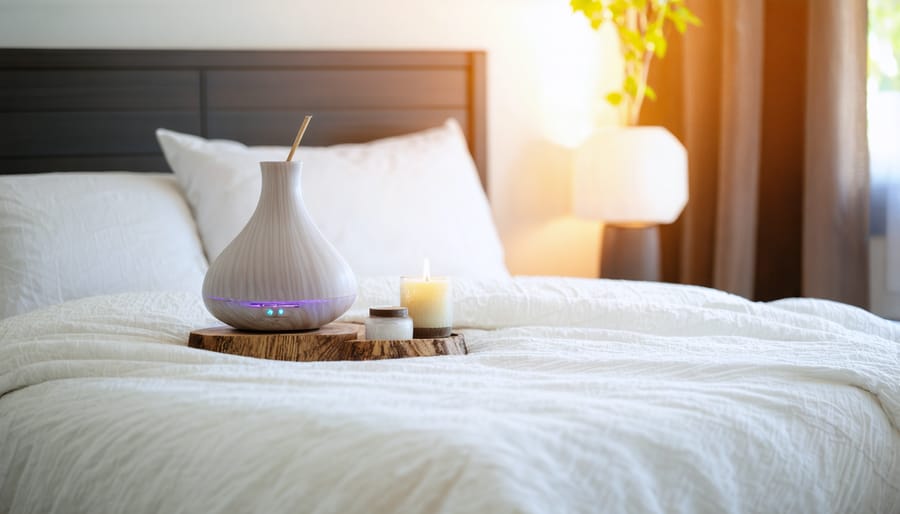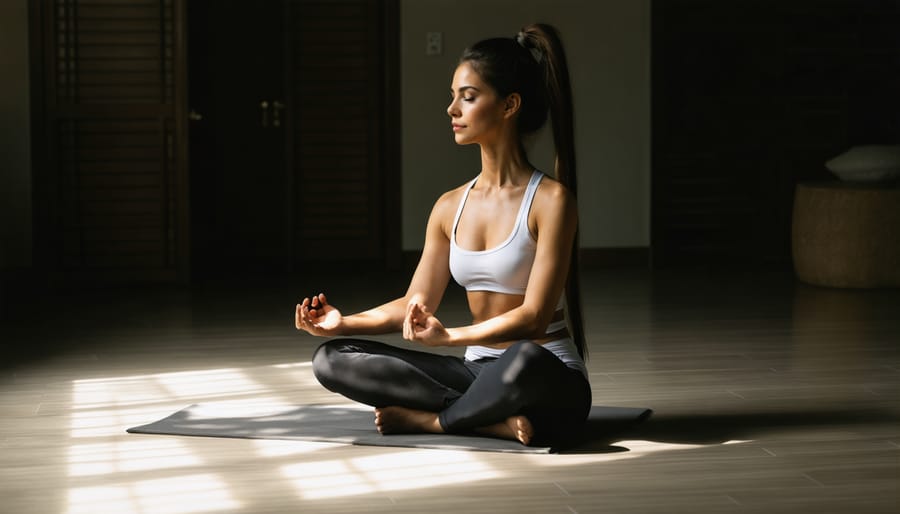
Close your eyes and take three deep breaths before bed tonight. This simple yet powerful gateway to better sleep opens the door to transformative mindful practices that can revolutionize your rest. In our constantly connected world, where midnight scrolling and racing thoughts have become unwanted bedfellows, mindfulness offers a natural path to peaceful, restorative sleep.
The relationship between mindfulness and sleep runs deeper than most realize. While tossing and turning might feel like your nightly routine, research shows that mindfulness can reduce sleep latency (the time it takes to fall asleep) by up to 50%. This isn’t just about relaxation—it’s about rewiring your brain’s approach to rest.
Think of mindfulness as your personal sleep concierge, gently guiding you from the chaos of day to the calm of night. Whether you’re dealing with occasional restlessness or chronic insomnia, incorporating mindfulness into your bedtime routine creates a bridge between wakefulness and sleep that your body naturally learns to cross.
Ready to transform your nights? Let’s explore how mindfulness can become your most powerful tool for achieving the deep, refreshing sleep you deserve.
The Science Behind Mindful Sleep
How Mindfulness Calms Your Racing Mind
Picture this: you’re lying in bed, but your mind is like a browser with 100 tabs open. We’ve all been there! Mindfulness acts as your mental declutter button, helping to reduce anxiety before bed and prepare your body for restful sleep.
When you practice mindfulness, your body undergoes amazing changes. Your heart rate slows, stress hormones like cortisol decrease, and your nervous system shifts from “fight or flight” to “rest and digest” mode. It’s like giving your mind permission to wind down naturally.
I remember when I first started practicing mindfulness before bed – it felt strange to simply observe my thoughts rather than chase them. But that’s exactly what makes it so powerful. By acknowledging our racing thoughts without judgment, we create space between ourselves and our stress.
The best part? This isn’t just feel-good advice. Research shows that regular mindfulness practice increases the production of melatonin (your sleep hormone) and reduces the mental chatter that keeps us tossing and turning. Think of it as a gentle reminder to your body that it’s safe to let go and drift into sleep.

Your Body’s Natural Sleep Signals
Have you ever noticed your eyelids getting heavy or caught yourself yawning more frequently in the evening? These are just some of the ways your body naturally signals it’s ready for sleep. As someone who used to push through these signals (hello, late-night Netflix!), I’ve learned that tuning into these cues can be a game-changer for better sleep.
Through mindful awareness, you can start recognizing your body’s sleep signals. Look for signs like increased blinking, mild body temperature changes, or that subtle mental fog that creeps in. My personal favorite indicator is when I notice myself reading the same sentence twice – that’s my body’s way of saying, “Time to wind down!”
When you’re mindful of these signals, you can work with your body’s natural rhythm instead of against it. Try setting aside a few moments each evening to check in with yourself. Are your shoulders feeling heavy? Is your mind starting to wander? These quiet observations can help you identify your unique sleep cues.
Remember, everyone’s sleep signals are different, and they might change depending on your daily activities or stress levels. The key is developing awareness of your personal patterns through gentle observation.

Creating Your Mindful Bedtime Ritual
The Perfect Wind-Down Timeline
Creating a peaceful evening routine has been a game-changer for my sleep quality, and I’m excited to share a timeline that works wonders. Think of this as your personal sleep preparation playlist – each step building on the last to help you drift off naturally.
2 Hours Before Bed:
Start dimming the lights and switch your devices to night mode. This is your cue to begin winding down. Enjoy a caffeine-free herbal tea like chamomile or lavender while tidying up your space for tomorrow.
90 Minutes Before:
Take a warm shower or bath. The gradual cooling of your body temperature afterward naturally signals it’s time for sleep. This is also the perfect time to apply your nighttime skincare routine mindfully, treating each step as a small act of self-care.
1 Hour Before:
Put away all screens and perhaps read a physical book or journal. This is your technology-free zone. Try some gentle stretching or a few calming yoga poses to release any physical tension.
30 Minutes Before:
Begin your mindfulness practice. This could be a 10-minute meditation, breathing exercises, or simply lying in bed and scanning your body for tension to release. Keep your bedroom cool and dark, using only soft lighting if needed.
15 Minutes Before:
Climb into bed and practice gratitude reflection or visualization. Focus on three things you’re thankful for from your day, letting go of any lingering stress or tomorrow’s to-do list.
Remember, this timeline is flexible – adjust it to fit your life while keeping the core principle of gradual unwinding intact.
Mindful Beauty Practices for Better Sleep
Transform your evening skincare routine into a mindful ritual that prepares both body and mind for restful sleep. When we approach beauty practices with intention, they become powerful tools for transitioning from day to night mode.
Start by creating a calming environment in your bathroom – dim the lights, light a gentle lavender-scented candle, or play soft instrumental music. As you begin your routine, take three deep breaths to center yourself. While cleansing your face, use gentle circular motions and focus on the sensation of the cleanser against your skin. Rather than rushing through the steps, treat each one as a mini meditation.
When applying your serums and moisturizers, practice gratitude for your skin and body. Use this time to massage your face with purpose, paying special attention to tension points like your temples and jaw. This facial massage not only helps products absorb better but also releases accumulated stress from the day.
Consider incorporating facial tools like a jade roller or gua sha stone. The cool touch of these tools combined with mindful strokes can be incredibly soothing. As you roll or stroke upward and outward, imagine releasing the day’s worries with each movement.
Remember, this isn’t about achieving perfect skin – it’s about creating a mindful transition to sleep. Even a simple three-step routine done with presence and intention can be transformative. Some people find it helpful to end their beauty ritual with a moment of meditation, sitting quietly with their eyes closed and feeling the products settle into their skin.
By approaching your evening beauty routine as a mindfulness practice, you’re not just caring for your skin – you’re preparing your entire being for peaceful rest.
Mindful Eating for Restful Nights
Sleep-Supporting Evening Recipes
As someone who struggled with nighttime anxiety, I’ve discovered that what we consume in the evening can significantly impact our sleep quality. Here are some of my favorite sleep-supporting recipes that have become part of my bedtime ritual.
Calming Golden Milk
Mix 1 cup of warm plant-based milk with ½ teaspoon turmeric, a pinch of black pepper, and a drizzle of honey. This ancient recipe contains compounds that reduce inflammation and promote relaxation.
Sleepy Time Smoothie
Blend 1 banana, ½ cup tart cherry juice, a handful of chamomile-steeped ice cubes, and a dash of vanilla. Tart cherries are natural sources of melatonin, while bananas provide sleep-supporting magnesium.
Lavender-Chamomile Tea
Steep 1 chamomile tea bag and ¼ teaspoon dried lavender in hot water for 5 minutes. Add a touch of honey if desired. Both herbs are known for their gentle sedative properties.
Sleep-Supporting Snack Bowl
Combine ¼ cup pumpkin seeds, a small handful of almonds, and 2-3 dried figs. This combination provides tryptophan, magnesium, and complex carbs that support quality sleep.
Remember to enjoy these treats at least an hour before bedtime to allow for proper digestion. The key is to keep portions modest – we’re aiming for gentle support, not a full meal that might disrupt sleep.
Timing Your Evening Meals
Like many of you, I used to grab dinner whenever I could squeeze it in, sometimes eating right before bed. But I’ve learned that timing our evening meals can make a huge difference in our sleep quality. The sweet spot? Try to eat dinner at least 2-3 hours before bedtime.
Think of your body like a busy kitchen that needs time to clean up after the last meal of the day. When we eat too close to bedtime, our digestive system is still hard at work when we should be winding down. This can lead to disrupted sleep and that uncomfortable feeling of being too full to rest properly.
I’ve found that aiming for dinner between 6:00 and 7:00 PM works wonderfully if you’re planning to hit the hay around 10:00 PM. This timing allows your body to properly digest your meal and starts the natural wind-down process that promotes better sleep.
If you absolutely must eat later, keep it light. A small protein-rich snack or some calming chamomile tea can satisfy those evening cravings without disrupting your sleep. I’ve noticed that many of my readers swear by a small handful of almonds or a warm glass of milk when they need something gentle on their stomach before bed.
Remember, consistency is key. Try to maintain regular meal times, as this helps regulate your body’s internal clock and supports your natural sleep-wake cycle.
Mindful Movement for Deep Sleep
Bedtime Yoga Sequence
As a former night owl turned sleep enthusiast, I’ve discovered that gentle movement before bed can work wonders for your sleep quality. Let me share my favorite bedtime yoga sequence that helps melt away the day’s tension and prepare your body for rest.
Start by sitting comfortably on your bed or yoga mat. Take three deep breaths to center yourself. Then, move into Child’s Pose, letting your forehead rest gently on the mattress or mat. Hold this nurturing position for 5-7 breaths, feeling the gentle stretch along your back.
Next, try the Legs Up the Wall pose – my personal favorite for releasing lower back tension. Simply lie on your back and extend your legs up against the wall. Stay here for 2-3 minutes, allowing gravity to do its magic.
Follow with a gentle Supine Twist: lie on your back, hug your knees to your chest, then let them fall to one side while keeping your shoulders grounded. Hold each side for 5-7 breaths.
Finally, end with Savasana (Corpse Pose) for 5 minutes. Let your body sink into the surface beneath you, consciously relaxing each muscle group from your toes to your head.
Remember, this sequence isn’t about perfection – it’s about creating a peaceful transition from your busy day to restful sleep. Feel free to modify these poses to suit your comfort level, and always move mindfully and gently.

Breathing Techniques for Better Sleep
Have you ever noticed how your breathing changes when you’re stressed versus when you’re relaxed? Our breath is incredibly powerful, acting as a bridge between our body-mind connection, and learning to harness it can transform your sleep quality.
Let me share my favorite pre-sleep breathing technique that’s been a game-changer for many in our community. It’s called the 4-7-8 method: inhale quietly through your nose for 4 counts, hold your breath for 7 counts, then exhale completely through your mouth for 8 counts. The key is to make your exhale longer than your inhale, which naturally triggers your relaxation response.
Another gentle approach is box breathing: imagine tracing a square with your breath, counting to four on each side. Inhale, hold, exhale, hold – each for four calm counts. This technique is particularly soothing when racing thoughts keep you awake.
For those nights when sleep feels especially elusive, try this: place one hand on your heart and one on your belly, then simply observe your natural breath for a few minutes. There’s no need to change anything – just feeling the rhythm of your breath can help quiet a busy mind and ease you into sleep.
Remember, these techniques become more effective with practice, so don’t get discouraged if you don’t feel immediate results. Your body will gradually learn to associate these breathing patterns with sleep time.
As we wrap up our mindful journey to better sleep, remember that creating a peaceful night’s routine isn’t about perfection – it’s about progress. Throughout this guide, we’ve explored how mindfulness can transform your relationship with sleep, from simple breathing exercises to creating a serene bedroom environment.
I’ve seen firsthand how these practices can make a difference. One of our community members, Sarah, shared how just five minutes of mindful breathing before bed helped her break free from a cycle of restless nights. Her story reminds us that small, consistent changes can lead to meaningful results.
The key takeaways are simple yet powerful: Start with short mindfulness practices, be patient with yourself as you develop new habits, and remember that quality sleep is a journey, not a destination. Whether you choose to begin with bedroom meditation, gratitude journaling, or gentle stretching, each mindful moment brings you closer to more restful nights.
Remember, everyone’s path to better sleep is unique. What works beautifully for one person might need adjustment for another, and that’s perfectly okay. The most important step is simply to begin.
Tonight, as you prepare for bed, try incorporating just one mindful practice we’ve discussed. Notice how it feels, adjust it to suit your needs, and gradually build upon it. Your future self will thank you for taking these steps toward more peaceful, rejuvenating sleep.
Sweet dreams, and may your mindful sleep journey bring you the rest and renewal you deserve.



